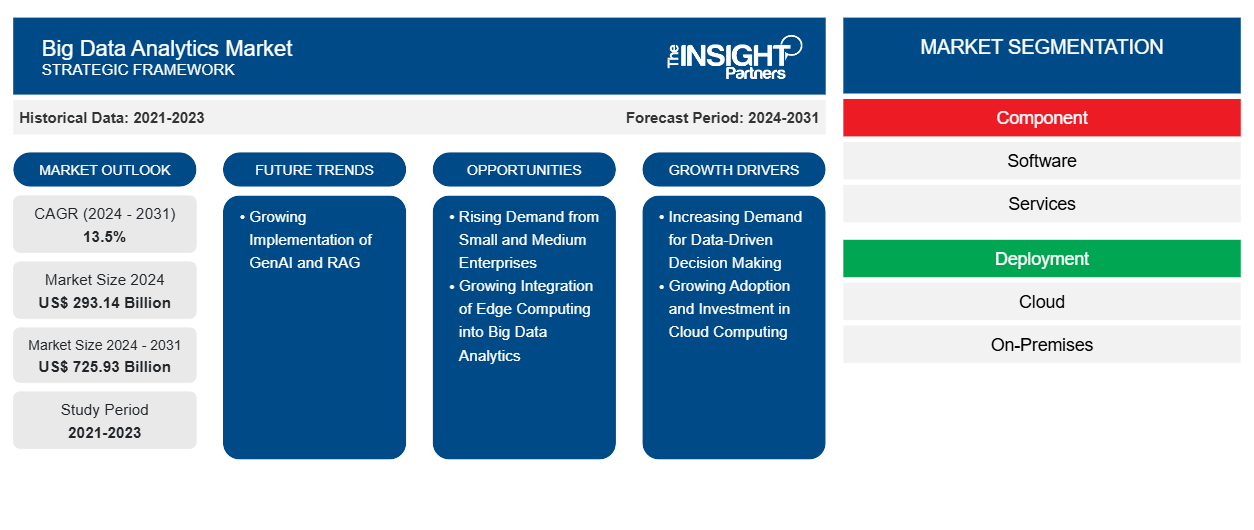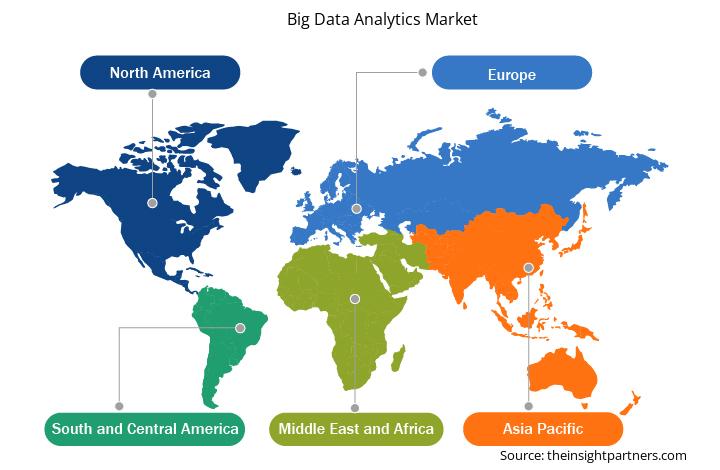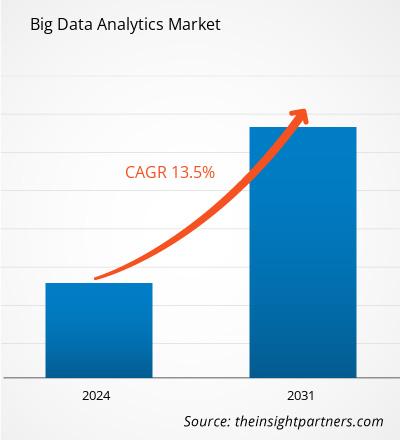大数据分析市场规模预计将从 2024 年的 2931.4 亿美元增至 2031 年的 7259.3 亿美元。预计 2024-2031 年期间市场复合年增长率将达到 13.5%。GenAI 和 RAG 的日益普及可能会在未来几年为市场带来新的趋势。
大数据分析市场分析
对数据驱动决策的需求不断增长以及对云计算的采用和投资不断增加等因素正在推动大数据分析市场的发展。由于中小企业 (SME) 的需求不断增长以及边缘计算 在大数据分析中的日益广泛应用,预计市场将在预测期内增长。GenAI 和 RAG 的实施可能会在未来几年为市场带来新的趋势。此外,由于各行各业产生的数据量不断增加以及组织从这些数据中获得可操作见解的需求不断增长,市场正在见证显着增长。其他驱动因素包括物联网 (IoT) 设备、社交媒体平台和智能设备的广泛采用,它们会产生大量数据,需要高级分析才能提取有意义的信息。
大数据分析市场概览
对降低成本和提高运营效率的日益重视,正在鼓励企业投资大数据分析解决方案。医疗保健、零售、金融和制造业等行业正在涌现出机遇,数据分析可以增强客户体验、优化供应链、改善财务决策并实现预测性维护。此外,人工智能 (AI) 和机器学习 (ML) 与大数据分析的结合为预测建模、个性化推荐和自动化开辟了新的可能性。就未来趋势而言,随着企业寻求可扩展性、成本效益和对分析平台的远程访问,市场预计将见证基于云的大数据解决方案的日益普及。
定制此报告以满足您的需求
您可以免费定制任何报告,包括本报告的部分内容、国家级分析、Excel 数据包,以及为初创企业和大学提供优惠和折扣
大数据分析市场:战略洞察

-
获取此报告的关键市场趋势。这个免费样品将包括数据分析,从市场趋势到估计和预测。
大数据分析市场驱动因素和机遇
云计算的采用和投资不断增长
云计算的日益普及和投资推动了大数据分析市场的增长。组织越来越多地利用云技术来处理和分析大量数据。这种转变正在改变企业处理数据管理、可扩展性和分析能力的方式。云计算提供了更好的基础设施、成本效益、可扩展性和高级功能,可以充分利用大数据分析的潜力,使企业能够更有效、更高效地做出数据驱动的决策。各大公司都在投资人工智能和云计算基础设施,这进一步推动了全球大数据分析的采用。下面提到了几个例子:
- 2024 年 10 月,微软做出重大承诺,投资 43 亿欧元(47.5 亿美元)扩建其在意大利的云和人工智能 (AI) 数据中心基础设施,突显了该公司的战略重点是巩固其在欧洲快速增长的数据分析市场中的地位。这项投资进一步支持了该地区的云计算,因为该地区的云计算已经经历了强劲增长,这得益于对高级 AI 解决方案、大数据分析和数字转型服务的需求不断增长。此次扩张将增强微软提供可扩展、安全和高性能云服务的能力,并与欧洲大数据分析的增长保持一致。
- 2024 年 6 月,为了满足西班牙对 AI 和云服务日益增长的需求,甲骨文宣布计划投资超过 10 亿美元在马德里建立第三个云区域。该计划旨在加速西班牙全国范围内 AI 专业知识的发展,同时增强甲骨文客户和合作伙伴的云能力,特别是在金融服务等领域。此次扩张反映了欧洲大数据分析应用日益广泛的趋势,因为企业越来越多地寻求先进的云解决方案来利用数据驱动的洞察力并推动金融和医疗保健等行业的创新。
边缘计算与大数据分析的日益融合
分布式数据处理使数据分析和处理更接近数据来源,从而减少对集中式云基础设施的依赖,并促进实时洞察。边缘设备可以处理复杂的预处理和过滤任务,从而帮助优化云资源以进行高级分析。这种更快的数据处理可以快速识别趋势和异常,从而增强运营层面的决策能力。
边缘计算为新兴应用铺平了道路,例如工业设备的预测性维护、实时交通管理和零售业的个性化推荐,从而促进了各个行业的创新。边缘计算的发展正在彻底改变大数据分析,它使数据能够在更接近其来源的地方进行处理,为企业提供实时洞察,提高运营效率,并开辟新的应用机会。尽管存在挑战,但持续的技术进步和对安全性的高度重视将促进边缘计算与大数据分析的顺利整合,推动业务运营的进一步创新和改进。
芯片技术、软件优化和安全协议的进步将解决现有的挑战。标准化边缘计算平台的出现将使该技术更易于访问,从而简化部署和管理。此外,设备上的人工智能和机器学习将使更接近源头的数据分析更快、更先进。边缘计算还将补充基于云的分析,形成一种优化数据处理和存储的混合架构。随着技术的发展,必须高度重视安全和隐私,以确保负责任的边缘计算实践。
因此,边缘计算与大数据分析的不断融合预计将在预测期内为市场增长创造机会。
大数据分析市场报告细分分析
有助于得出大数据分析市场分析的关键部分是组件、部署、应用程序和最终用户行业。
- 根据组成部分,大数据分析市场分为软件和服务。2024 年,软件部分占据了更大的市场份额。
- 在部署方面,大数据分析市场分为云和本地。2024 年,云部分将占据更大的市场份额。
- 根据应用,大数据分析市场细分为客户分析、营销分析、定价分析、劳动力分析等。其他部分在 2024 年占据了市场主导地位。
- 就终端用户行业而言,大数据分析市场细分为 IT 和电信、BFSI、医疗保健、零售等。其他细分市场在 2024 年占据了最大的市场份额。
大数据分析市场份额(按国家)分析
大数据分析市场报告的地理范围主要分为北美、欧洲、亚太地区(APAC)、中东和非洲(MEA)以及南美和中美。
2024 年,英国占据了相当大的市场份额。2024 年 10 月,四家美国大公司宣布计划向英国数据基础设施投资 63 亿英镑(783 亿美元)。这项在国际投资峰会上宣布的声明被科技大臣誉为对英国与企业合作促进经济增长战略的“信任投票”。CyrusOne、ServiceNow、CloudHQ 和 CoreWeave 是少数几家承诺进行大量投资的公司,它们对英国数据中心的总投资超过 250 亿英镑(311 亿美元)。这些新设施将大大增强该国的计算能力和数据存储能力,这对于开发和部署下一代基于 AI 的技术至关重要。此外,这项巨额投资凸显了英国大数据分析市场的快速增长,随着企业越来越认识到对强大数据基础设施的需求,该市场将继续扩大。凭借这些新数据中心,英国将自己定位为全球数据经济的关键参与者,提供必要的资源来支持对数据驱动解决方案、人工智能和机器学习日益增长的需求。随着医疗、金融和制造业等行业对高级数据分析的需求不断增长,英国数据基础设施的扩展对于促进创新和保持数字时代的竞争优势至关重要。这笔投资的涌入加强了英国作为数据中心的地位,并推动了该国更广泛的数字化转型计划。
大数据分析市场区域洞察
Insight Partners 的分析师已详细解释了预测期内影响大数据分析市场的区域趋势和因素。本节还讨论了北美、欧洲、亚太地区、中东和非洲以及南美和中美洲的大数据分析市场细分和地理位置。

- 获取大数据分析市场的区域特定数据
大数据分析市场报告范围
| 报告属性 | 细节 |
|---|---|
| 2024 年的市场规模 | 2931.4 亿美元 |
| 2031 年市场规模 | 7259.3亿美元 |
| 全球复合年增长率(2024 - 2031) | 13.5% |
| 史料 | 2021-2023 |
| 预测期 | 2024-2031 |
| 涵盖的领域 |
按组件
|
| 覆盖地区和国家 |
北美
|
| 市场领导者和主要公司简介 |
|
大数据分析市场参与者密度:了解其对业务动态的影响
大数据分析市场正在快速增长,这得益于终端用户需求的不断增长,而这些需求又源于消费者偏好的不断变化、技术进步以及对产品优势的认识不断提高等因素。随着需求的增加,企业正在扩大其产品范围,进行创新以满足消费者的需求,并利用新兴趋势,从而进一步推动市场增长。
市场参与者密度是指在特定市场或行业内运营的企业或公司的分布情况。它表明在给定市场空间中,相对于其规模或总市场价值,有多少竞争对手(市场参与者)存在。
大数据分析市场的主要公司有:
- 亚马逊网络服务公司
- 费埃哲
- 惠普企业公司
- 国际商业机器公司
- 微软公司
- 甲骨文公司
免责声明:上面列出的公司没有按照任何特定顺序排列。

- 了解大数据分析市场顶级关键参与者概况
大数据分析市场新闻和最新发展
大数据分析市场通过收集一手和二手研究后的定性和定量数据进行评估,其中包括重要的公司出版物、协会数据和数据库。以下列出了大数据分析市场的一些发展:
- SAS 宣布与值得信赖的政府 IT 解决方案提供商 Carahsoft Technology Corp. 达成新的分销协议。根据该协议,Carahsoft 将担任 SAS 公共部门分销商,通过 Carahsoft 的经销商合作伙伴以及各种合同载体和政府计划向美国政府机构提供该公司的分析、AI 和数据管理解决方案。(来源:SAS Institute's Inc.,新闻稿,2024 年 2 月)
- 互联多云数据平台 Teradata 为“日常 AI”平台 Dataiku 推出了一款新的分析集成组件。新的 Teradata Dataiku 插件旨在让使用 Dataiku 的分析和数据科学团队在 Teradata Vantage 平台内执行各种分析操作。(来源:Teradata Corp,新闻稿,2021 年 12 月)
大数据分析市场报告覆盖范围和交付成果
“大数据分析市场规模和预测(2021-2031)”报告对以下领域进行了详细的市场分析:
- 大数据分析市场规模以及全球和国家层面所有主要细分市场的预测
- 大数据分析市场趋势以及驱动因素、限制因素和关键机遇等市场动态
- 详细的 PEST 和 SWOT 分析
- 大数据分析市场分析涵盖主要市场趋势、全球框架、主要参与者、法规和最新市场发展
- 行业格局和竞争分析,涵盖市场集中度、热图分析、知名参与者以及大数据分析市场的最新发展
- 详细的公司简介
- 历史分析(2 年)、基准年、预测(7 年)及复合年增长率
- PEST和SWOT分析
- 市场规模、价值/数量 - 全球、区域、国家
- 行业和竞争格局
- Excel 数据集
近期报告
相关报告
客户评价
购买理由
- 明智的决策
- 了解市场动态
- 竞争分析
- 客户洞察
- 市场预测
- 风险规避
- 战略规划
- 投资论证
- 识别新兴市场
- 优化营销策略
- 提升运营效率
- 顺应监管趋势






















 获取免费样品 - 大数据分析市场
获取免费样品 - 大数据分析市场